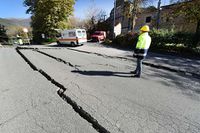From Visual Analytics for Business Intelligence
Jump to navigation
Jump to search
 IS428 VAST 2019 Mini Challenge 1
IS428 VAST 2019 Mini Challenge 1
Dataset Analysis & Transformation Process
| Issue |
Solution |
Resolution
|
| Issue 1: In the current dataset, “mc1-reports-data.csv”. The different categories of damage are a column by itself, making it difficult to compare the damage by the categories. |
Pivot the different categories of damage – sewer_and_water, power, roads_and_bridges, medical and buildings into a new column, “Damage Area”, with their respective damage level in a new column, “Damage Level (0-10)”. |
To do this, I used Tableau Prep’s “Pivot function” to make the changes. After applying the pivot function, you can see that I now have 2 new columns containing the data from sewer_and_water, power, roads_and_bridges, medical and buildings merged as one.
|
| Issue 2: In the given data – mc1-majorquake-shakemap.png, we can see that each value of Damage Level from 1 to 10 is categorized into the perceived shaking and we should align the values of each damage level as per the perceived shaking as well.
|
As seen from the data, damage level has 0 as well, but the perceived shaking does not include 0. However, since 1 is categorized as “not felt”, 0 should fit into this category as well since it is the mildest possible perceived shaking level. |
To do this, I have created a new calculated field / column, “Damage Category”, to bin all the values respectively (ie. damage level between 0-1 == “Not Felt”, damage level between 2-3 == “Weak”, damage level 4 == “Light”, damage level 5 == “Moderate”, damage level 6 == “Strong”, damage level 7 == “Very Strong”, damage level 8 == “Severe”, damage level 9 == “Violent” and damage level 10 == “Extreme”). Do the same for shake intensity and create a new calculated field/column, “Shake Intensity Category”.
|
| Example |
Example |
Example
|
| Example |
Example |
Example
|
| Example |
Example |
Example
|
Dataset Import Structure & Process

